Related Research Articles

Talc, or talcum, is a clay mineral composed of hydrated magnesium silicate, with the chemical formula Mg3Si4O10(OH)2. Talc in powdered form, often combined with corn starch, is used as baby powder. This mineral is used as a thickening agent and lubricant. It is an ingredient in ceramics, paints, and roofing material. It is a main ingredient in many cosmetics. It occurs as foliated to fibrous masses, and in an exceptionally rare crystal form. It has a perfect basal cleavage and an uneven flat fracture, and it is foliated with a two-dimensional platy form.

Garnierite is a general name for a green nickel ore which is found in pockets and veins within weathered and serpentinized ultramafic rocks. It forms by lateritic weathering of ultramafic rocks and occurs in many nickel laterite deposits in the world. It is an important nickel ore, having a large weight percent NiO. As garnierite is not a valid mineral name according to the Commission on New Minerals, Nomenclature and Classification (CNMNC), no definite composition or formula has been universally adopted. Some of the proposed compositions are all hydrous Ni-Mg silicates, a general name for the Ni-Mg hydrosilicates which usually occur as an intimate mixture and commonly includes two or more of the following minerals: serpentine, talc, sepiolite, smectite, or chlorite, and Ni-Mg silicates, with or without alumina, that have x-ray diffraction patterns typical of serpentine, talc, sepiolite, chlorite, vermiculite or some mixture of them all.
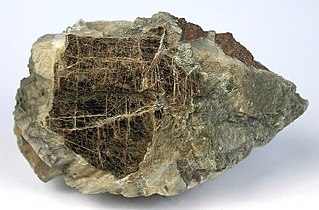
Clintonite is a calcium magnesium aluminium phyllosilicate mineral. It is a member of the margarite group of micas and the subgroup often referred to as the "brittle" micas. Clintonite has the chemical formula Ca(Mg,Al)
3(Al
3Si)O
10(OH)
2. Like other micas and chlorites, clintonite is monoclinic in crystal form and has a perfect basal cleavage parallel to the flat surface of the plates or scales. The Mohs hardness of clintonite is 6.5, and the specific gravity is 3.0 to 3.1. It occurs as variably colored, colorless, green, yellow, red, to reddish-brown masses and radial clusters.
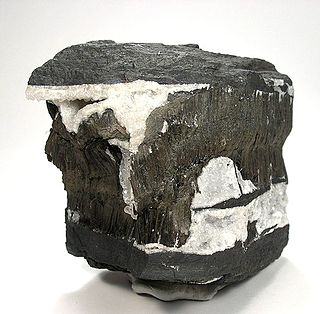
Todorokite is a complex hydrous manganese oxide mineral with generic chemical formula (Na,Ca,K,Ba,Sr)
1-x(Mn,Mg,Al)
6O
12·3-4H
2O. It was named in 1934 for the type locality, the Todoroki mine, Hokkaido, Japan. It belongs to the prismatic class 2/m of the monoclinic crystal system, but the angle β between the a and c axes is close to 90°, making it seem orthorhombic. It is a brown to black mineral which occurs in massive or tuberose forms. It is quite soft with a Mohs hardness of 1.5, and a specific gravity of 3.49 - 3.82. It is a component of deep ocean basin manganese nodules.
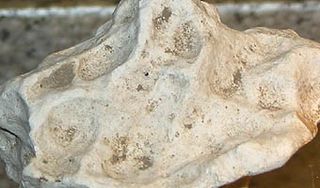
Sepiolite, also known in English by the German name meerschaum ( MEER-shawm, -shəm; German:[ˈmeːɐ̯ʃaʊm] ; meaning "sea foam"), is a soft white clay mineral, often used to make tobacco pipes (known as meerschaum pipes). A complex magnesium silicate, a typical chemical formula for which is Mg4Si6O15(OH)2·6H2O, it can be present in fibrous, fine-particulate, and solid forms.

Kerolite or cerolite is a metamorphic nickel bearing phyllosilicate mineral variety of talc, can be seen as a mixture of serpentine and saponite as well. It has the chemical formula (Mg,Ni)3Si4O10(OH)2·H2O. It is often considered as a talc variety and it was discredited 1979.

Zaratite is a bright emerald green nickel carbonate mineral with formula Ni3CO3(OH)4·4H2O. Zaratite crystallizes in the isometric crystal system as massive to mammillary encrustations and vein fillings. It has a specific gravity of 2.6 and a Mohs hardness of 3 to 3.5. It has no cleavage and is brittle to conchoidal fracture. The luster is vitreous to greasy.

Nickel(II) hydroxide is the inorganic compound with the formula Ni(OH)2. It is a lime-green solid that dissolves with decomposition in ammonia and amines and is attacked by acids. It is electroactive, being converted to the Ni(III) oxy-hydroxide, leading to widespread applications in rechargeable batteries.

Gaspéite, a very rare nickel carbonate mineral, with the formula (Ni,Fe,Mg)CO3, is named for the place it was first described, in the Gaspé Peninsula, Québec, Canada.

Népouite is a rare nickel silicate mineral which has the apple green color typical of such compounds. It was named by the French mining engineer Edouard Glasser in 1907 after the place where it was first described, the Népoui Mine, Népoui, Poya Commune, North Province, New Caledonia. The ideal formula is Ni3(Si2O5)(OH)4, but most specimens contain some magnesium, and (Ni,Mg)3(Si2O5)(OH)4 is more realistic. There is a similar mineral called lizardite in which all of the nickel is replaced by magnesium, formula Mg3(Si2O5)(OH)4. These two minerals form a series; intermediate compositions are possible, with varying proportions of nickel to magnesium.

Pimelite was discredited as a mineral species by the International Mineralogical Association (IMA) in 2006, in an article which suggests that “pimelite” specimens are probably willemseite, or kerolite. This was a mass discreditation, and not based on any re-examination of the type material. Nevertheless, a considerable number of papers have been written, verifying that pimelite is a nickel-dominant smectite. It is always possible to redefine a mineral wrongly discredited.

Ianbruceite is a rare hydrated zinc arsenate with the formula [Zn2(OH)(H2O)(AsO4)](H2O)2; material from the Driggith mine has traces of cobalt. It was first discovered at Tsumeb, approved by the International Mineralogical Association as a new mineral species in 2011, reference IMA2011-49, and named for Ian Bruce, who founded "Crystal Classics" in the early 1990s, and was heavily involved in attempts to reopen the famous Tsumeb mine for specimen mining.
In 2013 new occurrences of ianbruceite were reported from the neighbouring Driggith and Potts Gill mines on High Pike in the Caldbeck Fells, Cumbria, England. Here the mineral is probably a post-mining product. Caldbeck Fells and Tsumeb are the only reported localities for ianbruceite to date (May 2013).

Millerite is a nickel sulfide mineral, NiS. It is brassy in colour and has an acicular habit, often forming radiating masses and furry aggregates. It can be distinguished from pentlandite by crystal habit, its duller colour, and general lack of association with pyrite or pyrrhotite.

Köttigite is a rare hydrated zinc arsenate which was discovered in 1849 and named by James Dwight Dana in 1850 in honour of Otto Friedrich Köttig (1824–1892), a German chemist from Schneeberg, Saxony, who made the first chemical analysis of the mineral. It has the formula Zn3(AsO4)2·8H2O and it is a dimorph of metaköttigite, which means that the two minerals have the same formula, but a different structure: köttigite is monoclinic and metaköttigite is triclinic. There are several minerals with similar formulae but with other cations in place of the zinc. Iron forms parasymplesite Fe2+3(AsO4)2·8H2O; cobalt forms the distinctively coloured pinkish purple mineral erythrite Co3(AsO4)2·8H2O and nickel forms annabergite Ni3(AsO4)2·8H2O. Köttigite forms series with all three of these minerals and they are all members of the vivianite group.
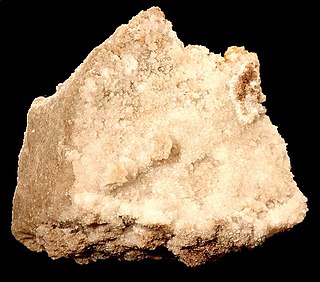
Talmessite is a hydrated calcium magnesium arsenate, often with significant amounts of cobalt or nickel. It was named in 1960 for the type locality, the Talmessi mine, Anarak district, Iran. It forms a series with β-Roselite, where cobalt replaces some of the magnesium, and with gaitite, where zinc replaces the magnesium. All these minerals are members of the fairfieldite group. Talmessite is dimorphic with wendwilsonite.
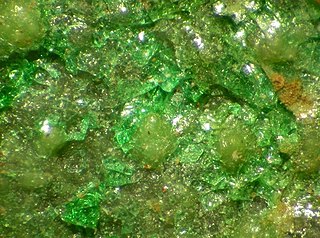
Widgiemoolthalite is a rare hydrated nickel(II) carbonate mineral with the chemical formula (Ni,Mg)5(CO3)4(OH)2·5H2O. Usually bluish-green in color, it is a brittle mineral formed during the weathering of nickel sulfide. Present on gaspéite surfaces, widgiemoolthalite has a Mohs scale hardness of 3.5 and an unknown though likely disordered crystal structure. Widgiemoolthalite was first discovered in 1992 in Widgiemooltha, Western Australia, which is to date its only known source. It was named the following year by the three researchers who first reported its existence, Ernest H. Nickel, Bruce W. Robinson, and William G. Mumme.
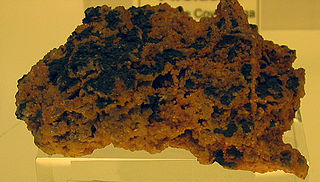
Asbolane is a manganese (IV) oxy-hydroxide mineral containing also cobalt, nickel, magnesium, and calcium ions. It crystallizes in the hexagonal crystal system. Its chemical formula is Mn4+(O,OH)2·(Co,Ni,Mg,Ca)x(OH)2x·nH2O.
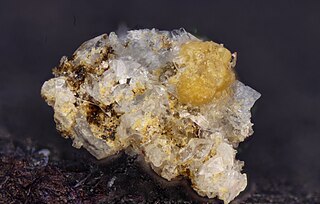
Zigrasite is a phosphate mineral with the chemical formula of MgZr(PO4)2(H2O)4. Zigrasite was discovered and is only known to occur in the Dunton Quarry at Oxford County, Maine. Zigrasite was specifically found in the giant 1972 gem tourmaline-bearing pocket at the Dunton Quarry. Zigrasite is named after James Zigras who originally discovered and brought the mineral to attention.
Alloriite is a silicate mineral that belongs to the cancrinite group, or more specifically the feldspathoid group. It is currently only found in Italy. It was discovered by and named for the Italian mineralogist Roberto Allori, an avid mineral collector who has also done research on piergorite and willhendersonite. The mineral appears as a crystal that is approximately 1.5 by 2mm in length. The crystal grows as both tabular and prismatic crystals, and commonly occurs with sanidine, biotite, andradite, and apatite. It was approved of being a mineral in 2006 by the International Mineralogical Association. Afghanite is a cancrinite group mineral that is very similar to alloriite in both its chemical composition and its physical properties.
Chukanovite is an iron(II) hydroxide-carbonate mineral with the ideal chemical formula Fe+22(CO3)(OH)2. It is a member of the rosasite mineral group and crystalizes in the monoclinic crystal system. Upon initial crystallization, it is typically pale green to colorless, but it takes on a brownish green hue after being altered at the surface. As a weathering product of meteoritic iron, chukanovite is a relatively uncommon mineral on Earth, having only been discovered in the year 2000. However, it is commonly formed artificially as a corrosion byproduct through the manufacturing of sand-deposited carbon steel.
References
- ↑ Warr, L.N. (2021). "IMA–CNMNC approved mineral symbols". Mineralogical Magazine. 85 (3): 291–320. Bibcode:2021MinM...85..291W. doi: 10.1180/mgm.2021.43 . S2CID 235729616.
- 1 2 3 4 5 6 "Falcondoite". www.mindat.org. Retrieved 2021-12-06.
- 1 2 3 4 "Falcondoite Mineral Data". webmineral.com. Retrieved 2021-12-06.
- 1 2 3 4 5 Springer, G (1976). "Falcondoite, Nickle Analogue of Sepiolite". Canadian Mineralogist. 14: 407–409.
- 1 2 Tauler, E., Proenza, J. A., Gali, S., Lewis, J. F., Labrador, M., Garia-Romero, E., Suarez, M., Longo, F., Bloise, G. (2009). "Ni-sepiolite-falcondoite in garnierite mineralization from the Falcondo Ni-laterite deposit, Dominican Republic" (PDF). Clay Minerals. 44 (4): 435–454. Bibcode:2009ClMin..44..435T. doi:10.1180/claymin.2009.044.4.435. S2CID 73659688.
{{cite journal}}: CS1 maint: multiple names: authors list (link)